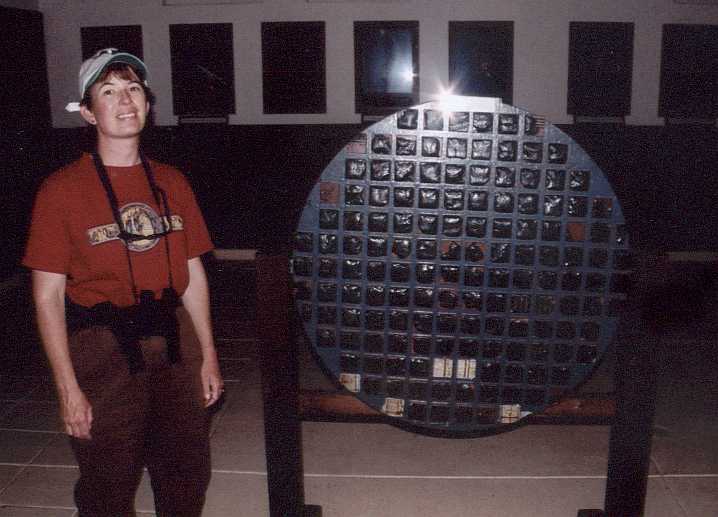
Mount Wilson is at 5715 feet on top of the steep San Gabriel mountains overlooking the LA basin (and just above all the smog). Its main claim to fame was having for many years the world's largest (diameter) telescopes: first from 1908 the 60-inch Hale reflector and later from 1917 to 1948 the 100-inch Hooker reflector, which was the biggest until the 200-inch was built for Mt. Palomar, near Escondido. We haven't been to Palomar yet, but have seen it in the distance from the top of Mt. San Jacinto above Palm Springs. Like all observatories, there is so much history here!

How's that for a mirror making tool?
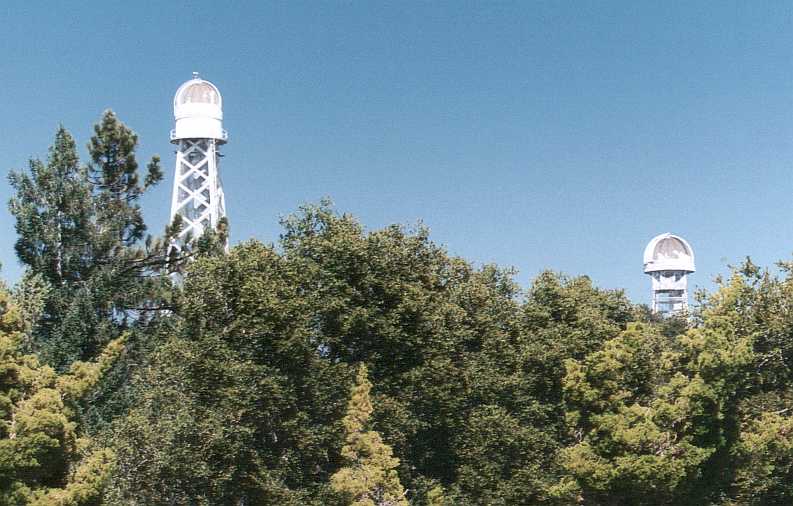
The 60 and 150-foot solar tower observatories were some of the first dedicated to studies of the sun. Like the Dunn solar scope at the NSO, the domes house mirrors mounted above ground-level atmospheric distortion and trees and send the light down a tube to instruments located on the ground below. Many pioneering studies and discoveries about the sun were made with these scopes.
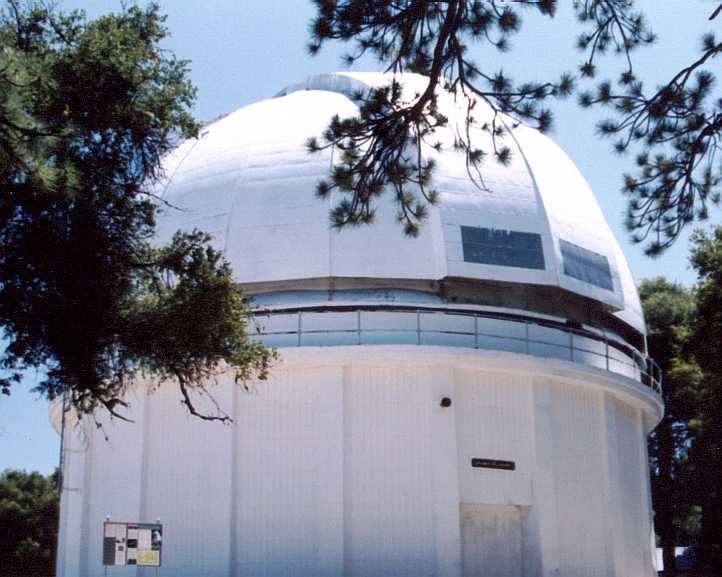
Above is the dome for the 60-inch Hale reflector. Compare this to the "dome" housing the 3.5-meter scope at Apache Point.
The 60-inch telescope was used largely for pioneering studies of spectral
classification and in adaptive optic technology. In 1957, physicist Robert
Leighton partially corrected, by a factor of 2 or 3, atmospheric blurring by
tilting the secondary mirror several times a second (a technique now
called "tip-tilt" correction). One of the first adaptive optics
systems designed -- Atmospheric Compensation Experiment (ACE)-- was
developed and used on the 60-inch telescope from 1992 to 1995. It is now
used for public viewing and is available to individuals and groups.
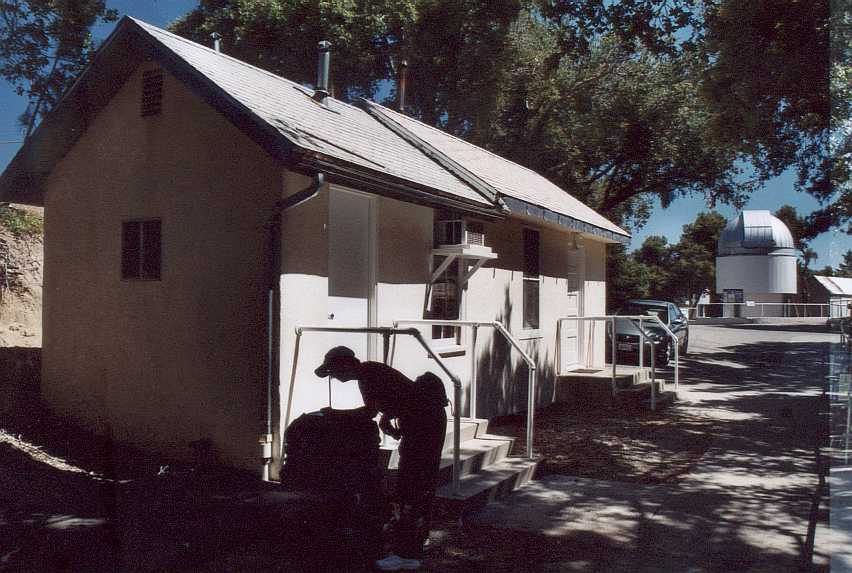
This is the old warming hut on the path to the 100-inch dome. Famous
astronomers and others, like Einstein, would hang out in here when it got
cloudy. There's a nice water fountain outside, a necessity in the cool,
dry air at 6000 feet. In the background is the dome for one of several
optical interferometers, whose light is sent down long pipes to one central
place and used to create one image. The flagship project of Georgia State
University's Center for High
Angular Resolution Astronomy (CHARA) is its optical/interferometric
array of six telescopes located on Mount Wilson. Each telescope of the
CHARA Array has a light-collecting mirror 1-meter in diameter. The
telescopes are dispersed over the mountain to provide a two-dimensional
layout that provides the resolving capability (but not the light
collecting ability!) of a single telescope a fifth of a mile in
diameter. Light from the individual telescopes is conveyed through
vacuum tubes to a central Beam Synthesis Facility in which the six beams
are combined together. When the paths of the individual beams are
matched to an accuracy of less than one micron, after the light
traverses distances of hundreds of meters, the Array then acts like a
single coherent telescope for the purposes of achieving exceptionally
high angular resolution. When fully operational, the Array will be
capable of resolving details as small as 200 micro-arcseconds,
equivalent to the angular size of a nickel seen from a distance of
10,000 miles (over 100 times the resolving power of the Hubble Space
Telescope). In terms of the number and size of its individual
telescopes, its ability to operate at visible and near infrared
wavelengths, and its longest baselines of 350 meters, the CHARA Array is
arguably the most powerful instrument of its kind in the world.
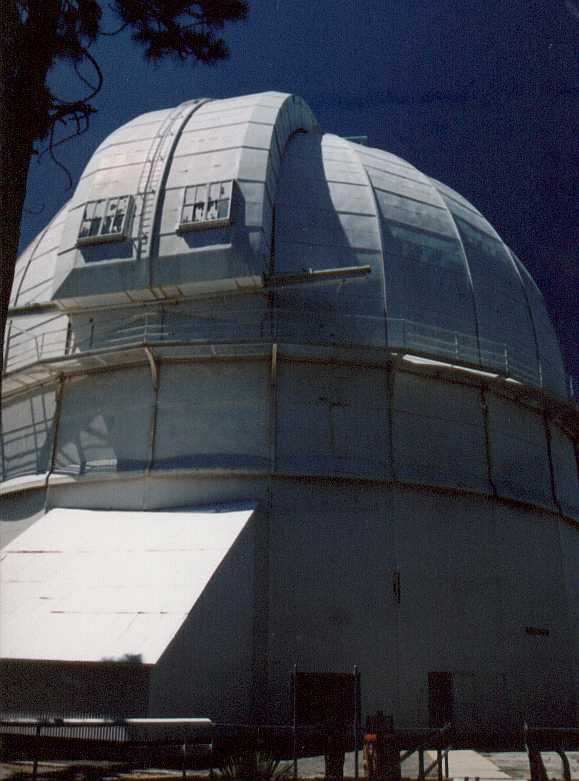
You can see how huge domes got by the late 19th century, even for "just" a 100-inch diameter reflector. All domes are essentially alt-azimuth mounts that move in a different manner than, and independent of, the equatorially mounted telescopes, and thus had to be big to accommodate the telescopes' spindly mounts (see below) and long focal lengths. By the late 1970s, with computers controlling alt-azimuth telescope mounts and the ability to make boxy, very short focal length/very wide diameter reflectors, the domes now just fit tightly around them or just roll out of the way! Compare the domes on this century-plus old site and the Mayall dome at Kitt Peak (among the last of the old breed), to the WYN at Kitt Peak and the larger telescopes at Apache Point.
As shown below, the 100-inch telescope is a classic of early 20th century telescopes, but got to be rather obsolete, it was not used from 1986 to 1994. But subsequent upgrades to its control systems and a state-of-the-art adaptive optics system have rejuvenated it!
